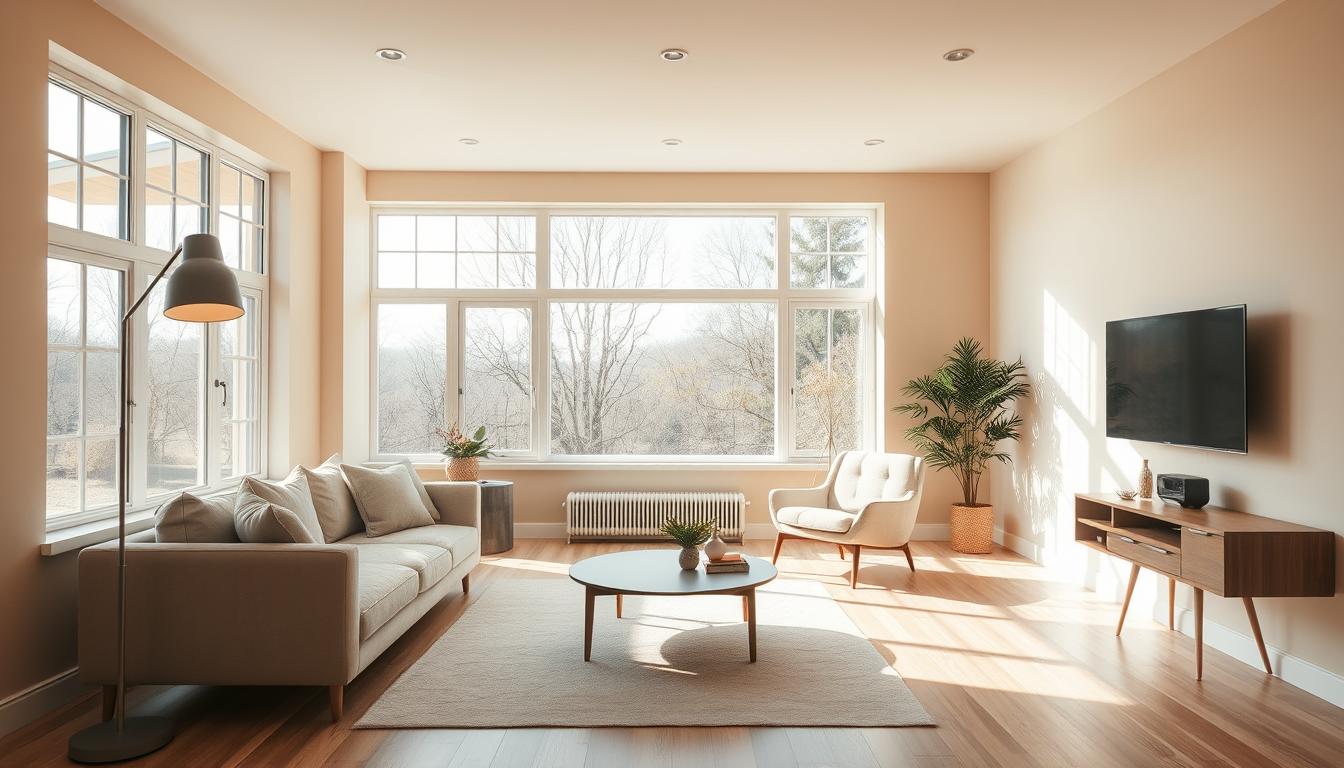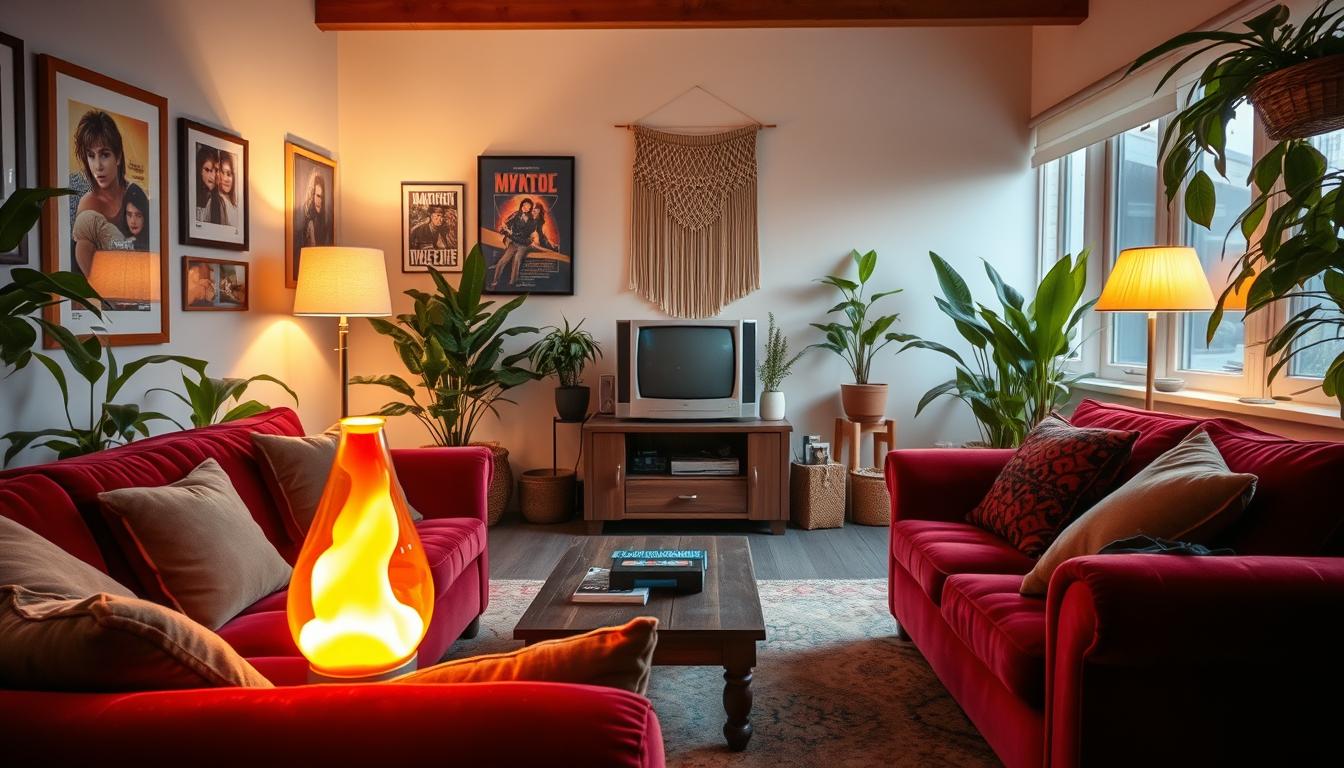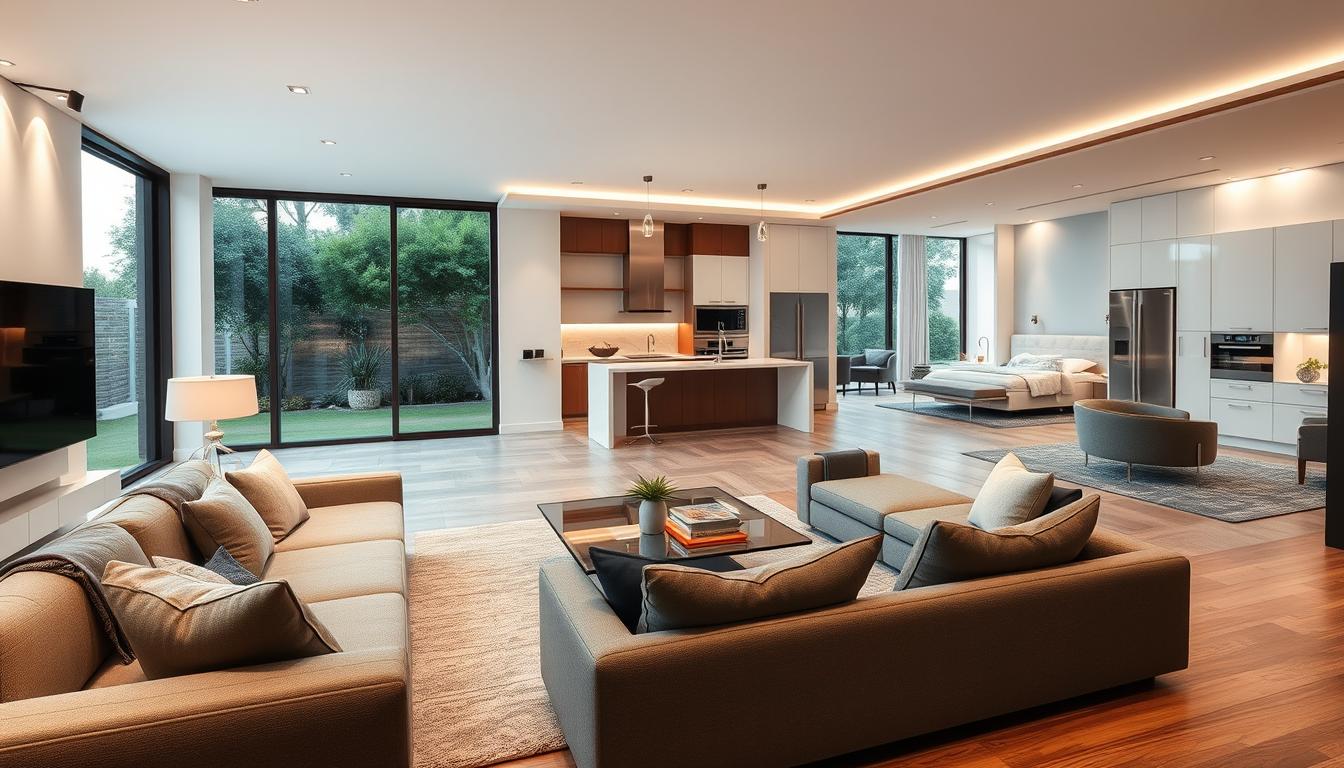Did you know a fresh coat of paint can boost your home’s value by up to 5%? Whether you’re selling or just want a new look, interior house painting is a smart choice. It makes your home look better.
We’re here to help you through it all. From picking the right interior paint color ideas to getting a smooth finish. Our guide will make you feel confident in your project.
Key Takeaways
- Understand the importance of choosing the right paint for your project.
- Learn how to prepare your walls for a professional-looking finish.
- Discover tips for selecting interior paint color ideas that enhance your home’s beauty.
- Get insights into the tools and materials needed for interior house painting.
- Find out how to avoid common mistakes during the painting process.
Why We Should Consider Painting Our Home’s Interior
Painting our home’s interior is more than just covering walls. It’s about making our living spaces more vibrant and inviting. A fresh coat of paint can give our homes a new life.
As the saying goes, “A fresh coat of paint can work wonders.” This is true for our home’s interior. It not only makes our home look better but also has practical benefits.
Benefits of a Fresh Coat of Paint
A new coat of paint can make our home feel fresher. It can:
- Brighten up dark rooms
- Cover up imperfections on the walls
- Create a sense of freshness and cleanliness
Painting our home’s interior is also a cost-effective way to update it. The interior painting cost is often lower than other home improvement projects. This makes it a good choice for homeowners who want to refresh their spaces without spending a lot.
Impact on Home Value and Aesthetics
Painting our home’s interior can also increase its value. A well-painted interior can attract more buyers if we decide to sell. Experts say hiring a reputable residential painting company can give us a good return on investment.
“A fresh coat of paint can increase a home’s value by making it look more modern and well-maintained.”
Also, a beautifully painted interior can change how we see our home. It can make our living spaces feel more welcoming and comfortable. Whether we want to update one room or our whole home, considering home painting services is a smart first step.
Choosing the Right Paint Color for Our Space
Finding the perfect paint color for our home’s interior can be tough. But with the right help, we can make a smart choice. The color we pick greatly affects our home’s feel and mood.
Understanding Color Psychology
Colors can make us feel different ways. Cool colors like blue and green calm us down. Warm colors like orange and red make us feel more energetic. Knowing how colors affect us helps us pick the right paint for our walls.
Let’s look at how colors affect our mood and how we see things:
| Color | Emotional Impact | Best Used In |
|---|---|---|
| Blue | Calming, Trusting | Bedrooms, Bathrooms |
| Red | Energizing, Stimulating | Living Rooms, Dining Rooms |
| Green | Balancing, Refreshing | Home Offices, Kitchens |
Popular Color Trends in 2023
In 2023, we’re seeing a move towards sustainable and calming colors. Earthy tones like terracotta and sienna are popular. So are soft blues and greens. These colors make us feel good and bring nature inside.
Testing Colors Before Committing
It’s key to test paint colors before deciding. We can paint samples on our walls or use online tools. This way, we see how the color looks in different lights and make sure we’re happy with it.
- Paint samples on the walls to see how the color looks in different lighting conditions.
- Use online visualizers to test different colors and combinations.
- Consider the color of our furniture and decor when making our decision.
Types of Interior Paint: What We Need to Know
The paint we pick for our interior walls is crucial. It greatly affects the final look. Knowing our options is key to getting the desired effect while thinking about health and the environment.
Differences Between Matte, Satin, and Gloss Finishes
Choosing the right paint finish is important. The finish changes how the paint looks and lasts. Matte finishes are flat and hide wall flaws well. But, they’re not as durable and can stain easily.
Satin finishes are a good middle ground. They’re easy to clean and last longer than matte. They work well in many rooms, even where moisture is a problem.
Gloss finishes are the most durable and easy to clean. They’re great for trim and doors. But, they show wall flaws and are very shiny.
Choosing Eco-Friendly Paint Options
Choosing eco-friendly paint is now more important. These paints use natural ingredients and have fewer harmful chemicals. They’re a good choice for those who care about the environment without sacrificing quality.
For more on painting costs and what to expect, check out https://homestylista.com/interior-painting-costs-what-to-expect-for-your-home/. It offers helpful tips on budgeting for your painting project.
Essential Tools and Supplies for Our Painting Project
For a professional paint job, preparation is key. We need the right tools and supplies. This ensures our painting project goes smoothly.
Must-Have Painting Tools
Interior house painting requires the right tools. Here are the essentials:
- Paintbrushes: Various sizes and shapes for different areas and effects.
- Rollers and extension poles: Great for covering large areas quickly and efficiently.
- Paint trays: Hold and transport paint.
- Paint roller covers: Different nap lengths for various surface textures.
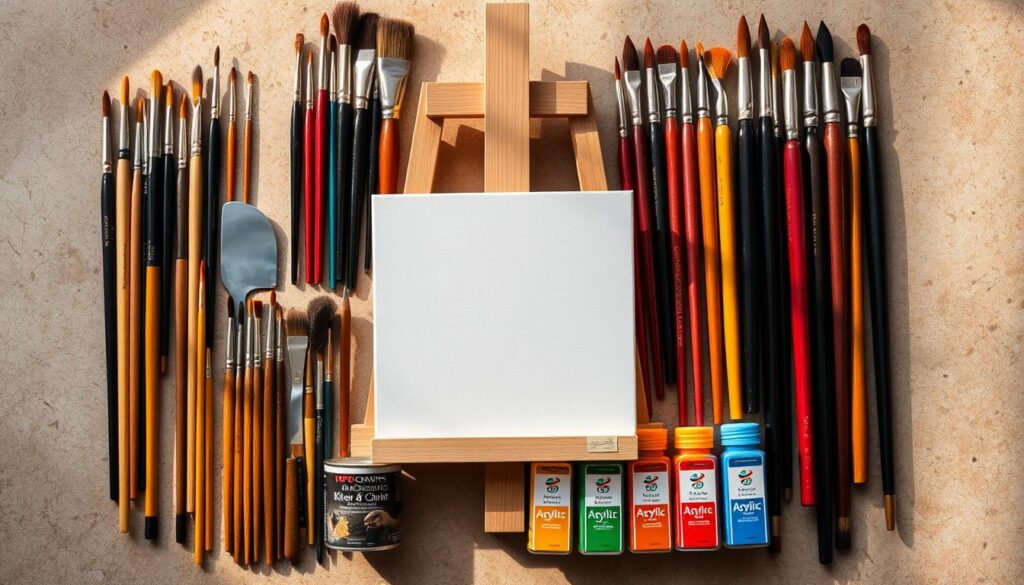
Additional Supplies for a Successful Job
There are more supplies that can greatly impact our project’s success.
- Drop cloths: Protect floors and furniture from paint spills.
- Masking tape: Creates sharp edges and lines.
- Painter’s tape: Specialized tape for painting.
- Cleaning supplies: Soap, water, and rags for cleaning tools and surfaces.
With these tools and supplies, we can have a successful painting experience. If unsure, we can seek advice from professional painting contractors near me.
Preparing Our Interior for Painting
Getting our interior ready for painting is more than just picking colors. It’s about the prep work, which is key for a smooth process. This prep work is crucial when we choose to paint the interior of our home.
Cleaning and Repairing Walls
First, we must clean our walls well. This removes dirt, grime, and grease. It’s important for the paint to stick well to the wall.
- Use a mild detergent and water to clean the walls.
- Fix any holes or cracks with spackling compound and sand smooth.
- Remove any old adhesive or tape residue.
Furniture and Floor Protection Tips
Protecting our furniture and floors is crucial to avoid damage. Here are some tips for preparing our home for painting:
- Move furniture away from walls or cover it with drop cloths.
- Use plastic sheets or tarps to protect floors from paint spills.
- Apply painter’s tape to trim and moldings to achieve clean, sharp lines.
By following these steps and tips, we can get a professional-looking finish. Proper preparation is essential for a successful painting project. With the right prep, we can achieve stunning results.
Techniques for a Smooth Painting Experience
Getting a smooth painting job is easier with the right tools and techniques. We need to know how to apply paint well to get a professional look.
Proper Brush and Roller Techniques
Choosing the right brush or roller technique is key. Brushes work best with long, smooth strokes for big areas. Rollers need gentle to moderate pressure in sections.
Rollers should have a wet edge to avoid lines. Work in small sections and use a ‘W’ or ‘M’ pattern to spread paint evenly.
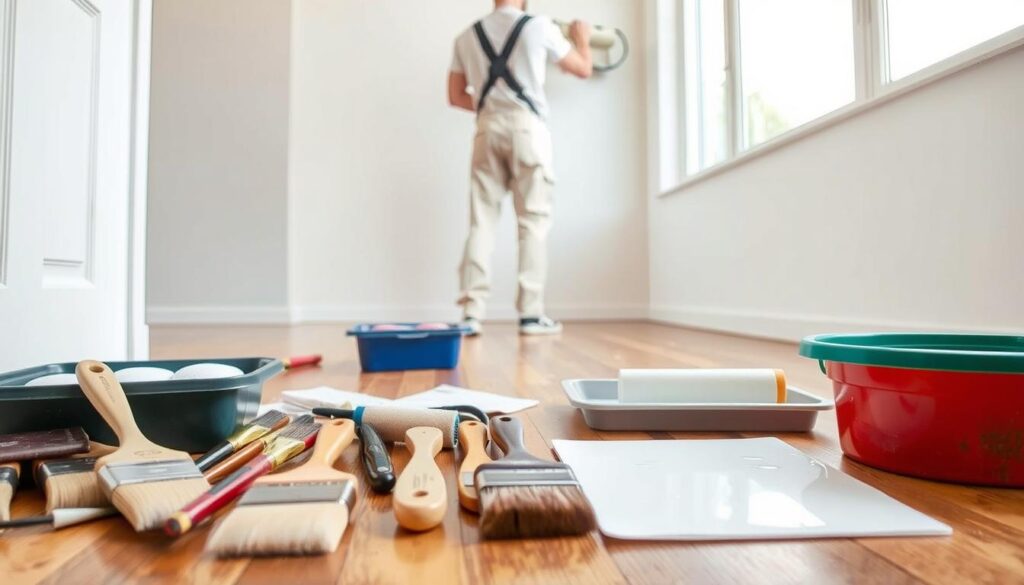
How to Use Tape Effectively
Painting tape helps create sharp lines. Apply it straight and smooth, pressing it firmly to prevent leaks.
Remove tape after the first coat to avoid damage. If you need more coats, reapply tape carefully to the same spot.
Tips for Effective Tape Use:
- Apply tape slowly and carefully to ensure straight lines.
- Press the tape firmly onto the surface.
- Remove the tape at a 45-degree angle to prevent pulling off the paint.
| Technique | Description | Benefit |
|---|---|---|
| Brush Strokes | Long, smooth strokes | Even coverage |
| Roller Pattern | ‘W’ or ‘M’ pattern | Prevents visible lines |
| Tape Application | Careful, firm application | Sharp edges and lines |
Safety Considerations While Painting Indoors
When painting indoors, safety is key. Painting can release harmful fumes and particles. These can be dangerous if we’re not careful.
Ventilation and Air Quality Tips
Good ventilation is crucial. Open windows and doors for fresh air. Use fans to move the air around.
Using a HEPA air purifier can also help. It removes particles and fumes from the air. This improves the air quality.
To improve ventilation even more, we can:
- Use exhaust fans to direct fumes outside.
- Avoid painting in enclosed spaces without proper ventilation.
- Take regular breaks to step outside for fresh air.
Protective Gear We Should Wear
Wearing the right gear is essential. This includes:
| Protective Gear | Purpose |
|---|---|
| Masks or Respirators | Filter out paint fumes and particles |
| Goggles | Protect eyes from splatters and spills |
| Gloves | Prevent skin contact with paint and chemicals |
| Coveralls or Old Clothing | Protect clothing from stains and splatters |
Wearing the right gear reduces our exposure to harmful substances. Choose best paint for interior walls with low VOC. This reduces fumes. Also, make sure professional interior painters follow safety rules.
Post-Painting Care and Maintenance
Now that we’ve finished painting, let’s talk about keeping our walls looking great. It’s important to take good care of our interior house painting job.
Cleaning Up After a Painting Session
After we finish painting, cleaning our tools is key. We should clean our brushes and rollers with soap and water. For oil-based paints, a solvent might be needed.
Don’t forget to clean our painting area. Remove tape, drop cloths, and plastic coverings. If we used painting contractors near me, they might have specific cleanup instructions.
How to Maintain Our Fresh Paint Job
To keep our paint looking fresh, we should regularly inspect our walls. Fixing scratches or marks quickly helps avoid bigger problems.
Here are some tips to keep our walls looking their best:
- Regularly dust our walls to prevent dirt buildup.
- Avoid using harsh chemicals or abrasive cleaners that can damage the paint.
- For scuff marks or stains, use a gentle cleaning solution and a soft cloth.
As Benjamin Franklin once said, “An investment in knowledge pays the best interest.” By following these maintenance tips, we’re investing in our interior house painting’s longevity.
“The way I see it, if you want the rainbow, you gotta put up with the rain.” –
This quote reminds us that a little maintenance is worth it for the beautiful results of our interior house painting project.
When It’s Best to Hire a Professional Painter
Painting our home’s interior can be a DIY task. Yet, there are times when hiring a pro is smarter. This is true for complex surfaces, detailed trim work, or big areas.
Signs we might need a pro include uneven surfaces, needing multiple coats, or not knowing the right paint for our walls. A professional can give us a top-notch finish and save us time.
Identifying Reliable Contractors
To find trustworthy painters, look for those with great reviews and a big portfolio. Make sure they’re licensed. Checking with the Better Business Bureau or local trade groups can help.
Benefits of Home Painting Services
Home painting services offer expertise, speed, and quality materials. This boosts our home’s look and might even raise its value.
FAQ
What is the best paint for interior walls?
How do I choose the right paint color for my home’s interior?
What is the average cost of interior painting services?
FAQ
What is the best paint for interior walls?
For interior walls, choose high-quality, low-VOC paint. Brands like Benjamin Moore, Sherwin-Williams, and Behr are good choices. They offer a variety of paints for different projects.
How do I choose the right paint color for my home’s interior?
Consider the room’s purpose, natural light, and furniture when picking a paint color. Testing colors with a sample or online visualizers helps. This ensures the color looks good in your lighting.
What is the average cost of interior painting services?
Interior painting costs vary based on area size, coats needed, and job complexity. Expect to pay to per square foot. For a standard home, costs range from
FAQ
What is the best paint for interior walls?
For interior walls, choose high-quality, low-VOC paint. Brands like Benjamin Moore, Sherwin-Williams, and Behr are good choices. They offer a variety of paints for different projects.
How do I choose the right paint color for my home’s interior?
Consider the room’s purpose, natural light, and furniture when picking a paint color. Testing colors with a sample or online visualizers helps. This ensures the color looks good in your lighting.
What is the average cost of interior painting services?
Interior painting costs vary based on area size, coats needed, and job complexity. Expect to pay $2 to $6 per square foot. For a standard home, costs range from $1,000 to $3,000.
Do I need to hire a professional interior painter?
If you’re short on time or not experienced, hiring a pro is wise. They ensure quality and save you time and effort.
How long does it take to paint the interior of a home?
Painting time depends on area size, coats, and job complexity. A pro can paint a standard home in 2-5 days. DIY projects take longer.
What are some popular interior paint color trends?
Trends include soft neutrals, bold brights, and rich jewel tones. Stay updated with forecasts from Sherwin-Williams and Benjamin Moore.
How do I prepare my home’s interior for painting?
Clean and repair walls, remove furniture, and protect floors with drop cloths and tape. Ensure good ventilation and wear protective gear to avoid paint fumes.
,000 to ,000.
Do I need to hire a professional interior painter?
If you’re short on time or not experienced, hiring a pro is wise. They ensure quality and save you time and effort.
How long does it take to paint the interior of a home?
Painting time depends on area size, coats, and job complexity. A pro can paint a standard home in 2-5 days. DIY projects take longer.
What are some popular interior paint color trends?
Trends include soft neutrals, bold brights, and rich jewel tones. Stay updated with forecasts from Sherwin-Williams and Benjamin Moore.
How do I prepare my home’s interior for painting?
Clean and repair walls, remove furniture, and protect floors with drop cloths and tape. Ensure good ventilation and wear protective gear to avoid paint fumes.

